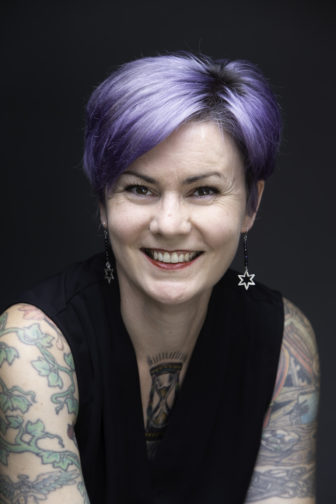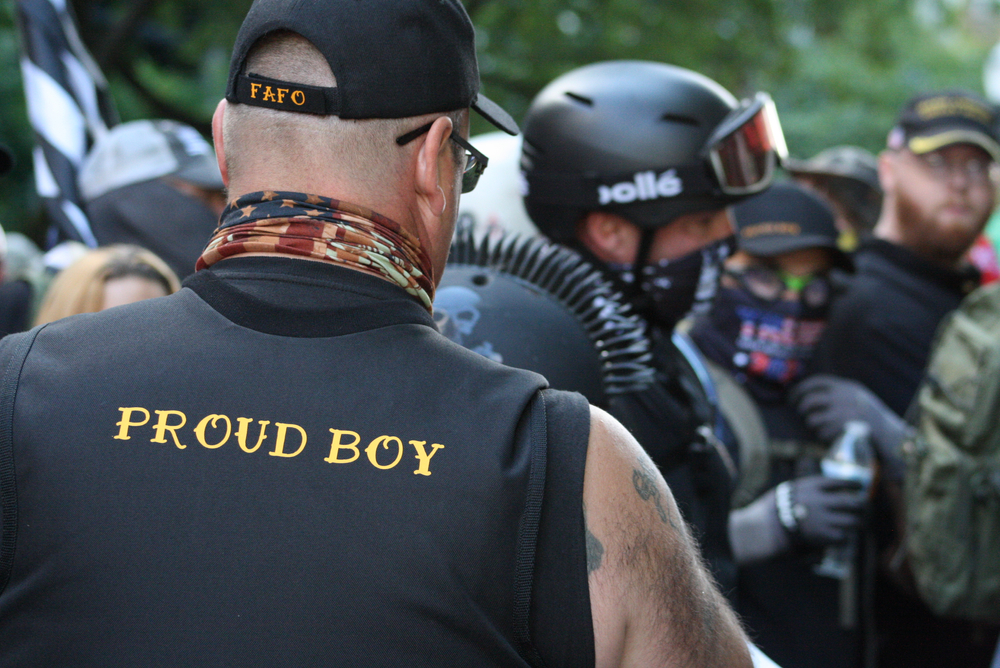Nora Flanagan’s first brush with hate group recruiting took place when she was 15 and living in Beverly, a southwest Chicago neighborhood. Her older brother brought home a couple of his friends. To Flanagan’s dismay, they’d shaved their heads and wore Confederate flags on their jackets. It signaled they were part of the burgeoning skinhead movement in Chicago in the late 1980s and early 1990s, led by a teen named Christian Picciolini.
“And they had been recruited and they were running around with this guy terrorizing the South Side. So, it literally came to my house,” Flanagan said. She hated the Nazi symbols scrawled on walls and the racist messages she was hearing.
“Christian was the reason I carried a baseball bat in my trunk in high school,” she said at a January presentation at the Wilmette Public Library in Chicago.
Today, however, the two work on a joint cause: countering the efforts of white nationalist groups to recruit vulnerable young people.
Now a high school English teacher in Chicago, Flanagan has co-authored a toolkit advising adults who work with youth. Picciolini, who long ago left the white nationalist movement, has spoken and written extensively about the danger of white nationalism.
Related Stories
Toolkit Can Help OST Workers Band Together to Respond To Hate Messages
Christian Picciolini: Why Teenager Joined, Then Quit White Power Movement

Nora Flanagan
Flanagan has a message for adults who work with youth: Organized youth activities outside school are often the first place where the signs appear that young people are dabbling in extremist ideology.
“It's where students feel comfortable,” she said. “We need the adults involved in those activities trained and we need them aware and we need them listening,”
Adults need to know the best way to respond, and all the adults in a young person’s life need to communicate around these issues. And out-of-school time programs can both defend and inoculate students against the problem.
Flanagan, now at Northside College Preparatory High School, said she has talked with teachers in a number of other schools about their experiences.
“These issues are coming up everywhere, even in schools we consider an oasis of diversity,” she said.
Look for a kid who seems detached, a kid who is increasingly resentful or a kid expressing hostility toward female teachers or LGBT people, she said.
Adults should not ignore early signs but neither should they respond in a manner that drives young people away, Flanagan said.
Don’t come crashing down on students
At Northside College Prep, a swastika was found carved on a chair in the library. The school didn’t ignore it. It was removed quickly and the school’s recently formed culture and climate team discussed how to watch for such messages in public spaces. An anonymous reporting system was created at the school.
What the school did not do was punish a whole group of students or “fixate” on identifying the student who did it. Such action would have shut down the school conversation and made students less likely to come talk about their concerns, according to Flanagan and her co-authors of the toolkit. The goal is to stand firm in protecting students from hate expressions. It’s also to open lines of communication.
“I've been teaching for 23 years, and I have found that at any time if something troubling [happens] my best first step is to pause, assess and ask questions. I definitely caution youth workers against making a scene,” Flanagan said.
If a student is saying something harmful and hurtful, she would stop a class in its tracks and address the situation “in the most productive and clear way possible.”
But if a student is wearing a T-shirt with offensive symbols, “I don't need to put on a show for everybody,” she said. “I don't need to make an example of that. That'll backfire really fast.”
Flanagan suggests first reaching out to other people who know the student.
Has anyone else noticed what the student is wearing or saying? Have there been changes in behavior inside or outside of school?
Ask the student: What did you mean by that? Where did you hear that?
“Sometimes it's really obvious that they are just bringing in what they're looking into online,” Flanagan said.
An important action is to communicate with the other adults who know the student. Don’t come crashing down on a kid to make an example, she warned.
“When you over-react specifically on a kid with extremist ideology, it just drives them further into that movement and you give them an opportunity to cast themselves as the victim,” Flanagan said.
But it’s also important not to under-react, she said.
Some administrators will say they don’t want to give an incident more attention than it deserves, she said. But by the time adults hear about something, all the students know and it’s probably happened a number of times. Under-reacting sends a message of lack of support to kids on the receiving end of hate messages, she said.
“We've told them that it’s not important enough for us to do anything significant,” Flanagan said.
In one incident described in the toolkit, a student distributing white nationalist literature was suspended from school — but was also provided counseling and a way to return. Restorative justice programs are also a tool that can both hold a student accountable and provide a way to rejoin the community.
It’s not the ideology, it’s the need to belong
Flanagan and Picciolini believe that kids who have gotten involved in extremist ideology are generally kids in need of something.
At the Wilmette Library event, Picciolini explained how he first became involved in the skinhead group. An older man befriended him. It made a big impact because, at age 14, Picciolinai was feeling alienated from others and didn’t feel he belonged anywhere.
People don’t gravitate to extremist groups initially because of the ideology, he said.
“We’re all on a search for identity, community and purpose in our lives,” Picciolini said at the event. “Had I discovered them in positive spaces, instead of through a skinhead on a grimy backstreet, my personal trajectory would have been much different.”
All the people he knew who became extremists did so because they wanted to belong, he said. They did not have the ideology at the start.
Young people become vulnerable when they hit “potholes” in life, he said. It may be an experience of loss or simply when a young person is marginalized and lonely.
In his newly published book “Breaking Hate: Confronting the New Culture of Extremism” Picciolini writes about Kassandra, 17, who was on the autism spectrum and felt distant from others and socially anxious. She was befriended in online chat groups by a man espousing racist and Nazi sentiments and who posed as her boyfriend.
And Daniel, growing up poor in Kentucky, whose mother was addicted to drugs and whose father was abusive, who joined the neo-Nazi group Hammerskin Nation.
And Omar, who felt marginalized and belittled as a Muslim in a culture he felt didn’t accept him, and joined ISIS.
Extremist recruiting crosses boundaries: It occurs among white nationalist groups as well as Islamic extremist ones.
Picciolini’s message at the Wilmette Library: “This is how we beat this: We provide these safe places and mentors for them to navigate these potholes and stay connected.”
In this formulation, out-of-school time organizations have an important role to play.
“Our kids need space and time and activities … with each other to socialize and develop and interact,” Flanagan said.
In her view, schools and communities can either pay for these activities or they will pay in other ways.
Young people need supportive adults to see when they are struggling and to spot which kids might be vulnerable, and they need adults to reduce that vulnerability by offering options and activities and a way to belong, she said.
Flanagan also said social emotional learning and critical thinking skills are vital to countering extremism among you, as is having a school library where kids learn to process and filter informatio

It amazes me how the larger issue facing our country is exactly the opposite of what this article says. What we need are more articles advising young people how to deal with their parents, relatives, teachers, coaches, clergy, and aging grownups around them who are succumbing to extremist ideologies. We have plenty of surveys and social science research to show that far-right extremism rises with age, and that teenagers and young adults are the most resistant to hate ideologies. Certainly, there are some young people involved (often ones whose families are likewise inclined), but the mass of the hate movement consists of the old. It wasn’t high schoolers who stormed the Capitol on January 6; arrest statistics show the violent haters averaged over 45 years old. It may make us older folks feel good to depict ourselves as the tolerant rescuers of warped kids — just like we hype “youth at risk” while ignoring the epidemics of suicide, drug abuse, crime, and other troubles afflicting older generations — but that is not the reality teens face. We adults need to put aside our egos and smugness and recognize that too often, we’re not the solution, we’re the problem. We need to start seeing ourselves as learners, not rescuers.